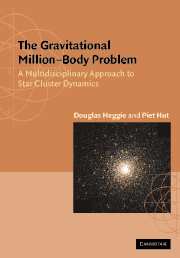Book contents
- Frontmatter
- Contents
- Preface
- PART I INTRODUCTIONS
- PART II THE CONTINUUM LIMIT: N → ∞
- PART III MEAN FIELD DYNAMICS: N = 106
- PART IV MICROPHYSICS: N = 2
- PART V GRAVOTHERMODYNAMICS: N = 106
- PART VI GRAVITATIONAL SCATTERING: N = 3
- PART VII PRIMORDIAL BINARIES: N = 4
- PART VIII POST-COLLAPSE EVOLUTION: N = 106
- PART IX STAR CLUSTER ECOLOGY
- Appendix A A Simple N-Body Integrator
- Appendix B Hints to Solution of Problems
- References
- Index
PART VI - GRAVITATIONAL SCATTERING: N = 3
Published online by Cambridge University Press: 05 June 2012
- Frontmatter
- Contents
- Preface
- PART I INTRODUCTIONS
- PART II THE CONTINUUM LIMIT: N → ∞
- PART III MEAN FIELD DYNAMICS: N = 106
- PART IV MICROPHYSICS: N = 2
- PART V GRAVOTHERMODYNAMICS: N = 106
- PART VI GRAVITATIONAL SCATTERING: N = 3
- PART VII PRIMORDIAL BINARIES: N = 4
- PART VIII POST-COLLAPSE EVOLUTION: N = 106
- PART IX STAR CLUSTER ECOLOGY
- Appendix A A Simple N-Body Integrator
- Appendix B Hints to Solution of Problems
- References
- Index
Summary
Core collapse leads to high stellar densities, where interactions may involve more than just two stars at a time. The chapters in this section are therefore devoted to three-body interactions, especially interactions between a binary star and a single star. One of our aims in these chapters is to show that important aspects of the three-body problem can be understood from various points of view, even though the problem itself lacks a general mathematical solution.
Chapter 19 takes a phenomenological approach, applying notions of equipartition and energy conservation. This already classifies encounters according to whether the binary is hard or soft. In some interactions with hard binaries the result (temporarily) is like a miniature star cluster of three stars, and our previous knowledge of the behaviour of star clusters can suggest how this evolves.
Chapter 20 takes an informal mathematical view of the same phenomena. We see that the breakup of triple star clusters exhibits a sensitive dependence on initial conditions, partly justifying a statistical treatment. One of the standard examples in which this is most readily understood is Sitnikov's problem, which we use to introduce the Smale horseshoe. Finally we prove informally a theorem which shows that permanent capture into a triple configuration is (practically) impossible, and end with some recent surprising discoveries about permanently bound triple systems.
Chapter 21 takes a course halfway between the previous ones, exploiting a mixture of approximate analytical tools and physical arguments to develop theoretical results on the outcome of three-body interactions.
- Type
- Chapter
- Information
- The Gravitational Million–Body ProblemA Multidisciplinary Approach to Star Cluster Dynamics, pp. 179 - 180Publisher: Cambridge University PressPrint publication year: 2003



